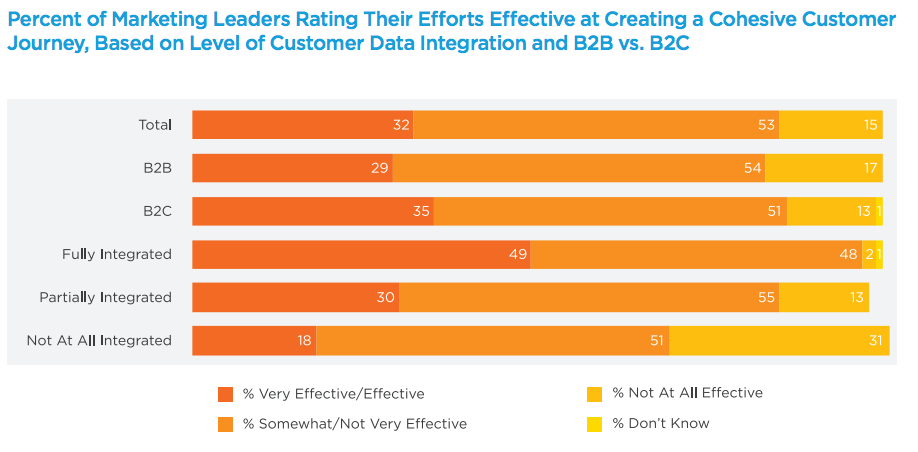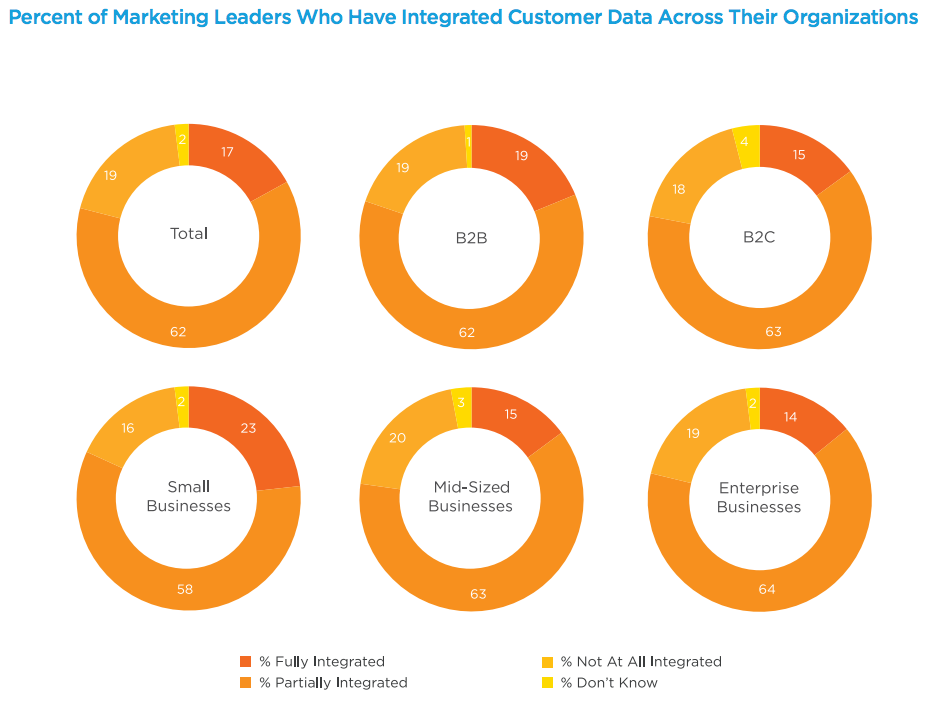
Get your FREE 30-day trial.
Please complete all fields.
 In my recent post, I discussed how regardless of whether a company uses the term “customer journey,” most marketing leaders (86%) agree on the importance of creating a cohesive customer journey across all touchpoints and channels.
In my recent post, I discussed how regardless of whether a company uses the term “customer journey,” most marketing leaders (86%) agree on the importance of creating a cohesive customer journey across all touchpoints and channels.
Even senior-level marketers who work for companies that don’t
use the term see the value: 83% of marketing leaders whose companies don’t use the term “customer journey” still believe it is absolutely critical or very important for their marketing team to create one, compared to 93% of marketers from companies who do use the term.
In our latest research report, The State of Marketing Leadership, we also found integrating customer data is proving to be a critical part of refining that customer journey.
The State of Marketing Leadership
How Senior-Level Marketers are Redefining Success and Integrating the Customer Journey
{Download Now}
Companies That Integrate Customer Data vs. Those That Don’t
Most marketers believe their marketing team is at least somewhat effective at creating a cohesive customer journey: 85% of total marketers say their company does it either somewhat or very effectively. When you compare companies who have fully integrated customer data systems to those that
haven’t, however, the major effect of data integration on the customer journey becomes clear.
Only 17% of respondents said their company had fully integrated their customer data across all areas of the organization. However, 97% of those “fully integrated” marketing leaders said they were at least somewhat effective at creating a cohesive customer journey across all touchpoints and channels.
In other words, senior-level marketers who have successfully integrated their customer data ranked their effectiveness considerably higher than those who had no integration at all, as shown in the following chart.

Sixty-two percent of senior-level marketers said their data was partially integrated, 19% had no integration, and 2% were unsure. Enterprise-level businesses reported lower levels of data integration within both B2B and B2C companies, as shown in the following chart. So while enterprise companies
may enjoy greater budgets and resources, they may also suffer from longer approval processes and decreased agility. Smaller businesses are leading the way in customer data integration and should serve as a model for less agile corporations.

Obstacles to Customer Data Integration
We asked senior-level marketers to share the top obstacles preventing them from having a fully integrated customer data
system. One of the largest obstacles expressed by senior-level marketers was a lack of integration between sales and marketing. Other areas
where marketers struggled included too many customer communications and lack of understanding about which activities influence behavior:
“We have good sales data. We have good customer data. We don’t do a good job of flowing sales data into customer data when someone buys.” – Director, enterprise B2B
“We have difficultly tracking our customer interactions across groups. As a result, clients receive too many communications.” – Vice president, enterprise B2B
“We don’t have a full picture of our customer, so there are missed opportunities with segmented/personalized marketing.” – Director, mid-sized B2C
“The lack of customer data integration makes it difficult to close the loop in regards to our reporting capabilities, our ability to better measure Marketing’s
attribution to revenue, improve our behavioral targeting capabilities, and use the insights gained from data integration analyses to optimize future marketing
efforts and change the overall marketing mix to reach customers more effectively.” – Owner, small B2B
Customer data integration is key to developing a single view of the customer and moving each one along a responsive and effective journey. Unfortunately, data disparities are plaguing marketers and impeding the creation of those journeys in many cases—16% of small business, 20% of mid-sized business, 19% of enterprise, 19% of B2B, and 18% of B2B respondents said their customer data systems were not at all integrated.
It’s clear that improved customer data integration results in impressive customer journey benefits, so we recommend that marketing leaders use these numbers to prioritize better customer data processes in their own organizations.
For more data and insights from our latest survey of more than 900 senior-level marketers, download the full report — The State of Marketing Leadership. This latest report was a joint research report with LinkedIn and Salesforce Marketing Cloud.